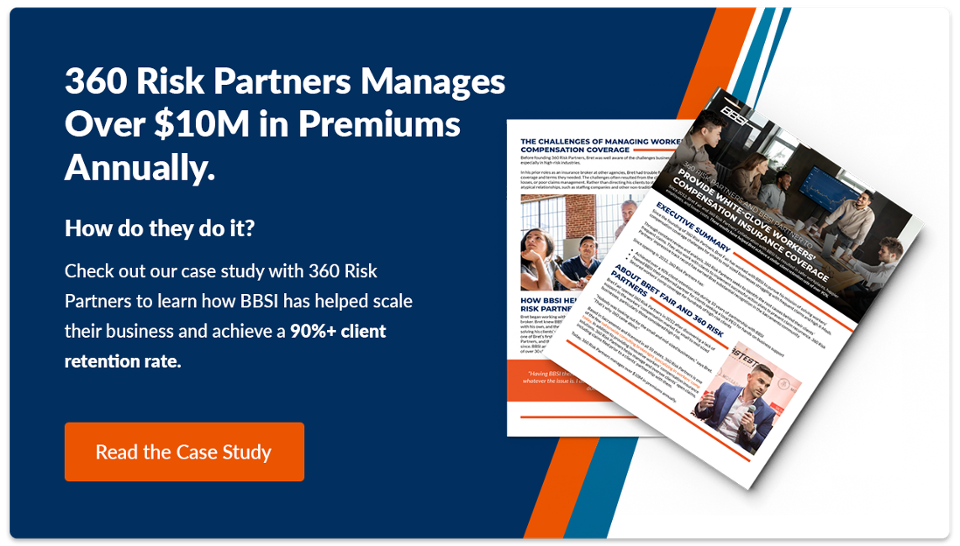Where to Start When Consulting with a High X-Mod Client

Workers’ compensation insurance represents a significant percentage of a business' costs, making it a crucial topic for brokers to understand. The more knowledge brokers have, the better prepared they will be in educating their clients on experience modifiers (X-Mods) and how they affect their premiums.
How Experience Modifiers (X-Mods) are Calculated
To calculate the X-Mod, one divides the actual losses incurred by the expected losses from a particular client. This rate is a reflection of the business’ claims experience and history. All clients will start at a 1.00 mod, increasing or decreasing over time based on the losses.
A 1.00 X-Mod is applied for an employer who has demonstrated losses (claims) equal to the expected loss rate. When performance drops, the X-Mod increases, and vice versa. Insurers generally strive for a loss ratio (the number of losses divided by the premium) to be under 100%. The rate is calculated annually as a way to determine the premium the client ends up paying.
Is a High X-Mod Client Beneficial to Brokers?
A high X-Mod does mean the client pays a higher premium, which also means the broker gets a higher commission. However, the higher the X-Mod, the higher the risk that the business owner will experience claims. Even a single claim can lead to insurmountable costs, putting the business at risk of closing and the broker at risk of losing their client. A broker’s ability to help their clients lower their experience modifiers will strengthen the relationship while making tangible impacts on the client’s operation. That growth leads to more employees and higher payrolls which, in turn, increases commission potential for the broker.
Why Should Rising X-Mods Be a Concern for Brokers?
Most clients will not accept workers’ compensation premium increases without additional questions, and some will need support from their insurer to lower their X-Mod (and premium).
The perk of a commission increase can be short-lived when there is a rising X-Mod involved, which could create several problems in the broker/client dynamic:
- Unhappy clients - Clients who are upset that their premiums increased and didn’t receive a detailed explanation will likely become frustrated with the broker handling their contract.
- Shopping the market - The client will decide to look for better rates with another broker. Brokers and large PEOs are now targeting clients directly with personalized offers that, on the surface, could appear more favorable.
- Higher risk for major claims - An increasing X-Mod is generally a sign of increased claims, which could signify underlying issues that increase the potential risk of a business closure.

What the Client Wants to Know About Their Rising X-Mods
When business owners begin to see their X-Mod rise, they may ask the following fundamental questions to their brokers:
- Why is this happening?
- What does it mean?
- How can my broker help?
This moment can be an excellent opportunity for the broker to considerably strengthen their relationship with the client. This is also where BBSI can assist the broker and the client in discussing how to reduce their X-Mod.
A business will usually get assigned an X-Mod for the first three years of the contract. When the X-Mod goes up, BBSI recommends that our brokers work with the client to help them reduce their X-Mod.
Decreasing an X-Mod is a long-term process, and the client may require a lot of support to achieve this goal, which is why BBSI’s HR and Risk & Safety services can be so valuable to brokers and clients.
Actively Working to Reduce X-Mod’s is One Great Retention Strategy. Want More?
What Are the Best Ways to Help Clients Manage Their X-Mods?
Brokers looking to assist their clients in managing their X-Mods have many options at their disposal.
Depending on client needs and the exact reasons an X-Mod is increasing, brokers can focus on any of these strategies:
1. Review workplace safety procedures
Lackluster safety procedures are a sure-fire way for businesses to face increased claims, resulting in an increased X-Mod. Brokers can review company safety procedures to identify any significant risk areas the employer should address to reduce these risks.
BBSI Risk Managers offer a unique risk assessment checklist to all of our clients at the onset of our partnership for this very purpose.
2. Establish good hiring gates
Better hiring practices lead to better employee performance, which typically results in fewer claims and higher productivity. Employers should consider adopting certain hiring gates to ensure their talent acquisition strategy aligns with their needs. Hiring gates, like reference checks and drug screens, can be significant barriers to cross to gain employment.
Brokers can talk with management to determine if they have higher turnover than desired or if new employees often require more training than what would typically be required. These insights can signify that a company’s hiring practices do not align with the expectations of the position. Brokers can also help by reviewing job descriptions and comparing them to the actual expectations of the position. Any discrepancies noted should be corrected ASAP.
BBSI can support this goal with HR and staffing services that help match your client’s hiring needs with members of our extensive and diverse talent pool. A BBSI HR Consultant will help take some of the pressure off the broker's shoulders by working with business owners to create hiring gates that bring in better people and positively impact employee retention rates.

3. Analyze claims to identify patterns
Claims patterns are clear indicators of specific risk factors impacting an operation. If an employer has multiple claims with similar injuries, for instance, this is a clear indicator that operations need to be examined to improve employee safety. Patterns can also be found when a large percentage of claims are made by employees from a single department. This common thread shows a business owner that there could be an issue with job site conditions or leadership training.
Brokers who meet with clients to review claims for patterns and trends may uncover hidden threats the business owner hadn’t yet identified. This exercise builds trust and rapport and can be a great starting point to bring in a dedicated team of HR and risk and safety professionals with specific goals in mind.
4. Recommend training programs
If the broker notices specific patterns, they can recommend various training programs to help their clients reduce risks and ultimately, X-Mods. These recommendations can significantly impact the client’s operations, from risk and safety training courses to management classes.
5. Turn to a non-traditional PEO
Usually, a Professional Employer Organization (PEO) can be attractive for high-X-Mod clients because the client’s X-Mods are replaced with that of the PEO’s. But non-traditional providers like BBSI offer more than premium relief.
With BBSI, your clients get a team of professionals in their specific fields of HR, management, payroll, staffing, and risk/safety management all included with their workers’ comp policy. This support takes much of the focus on reducing risk and managing premiums off your plate, so you can focus on continuing to grow your book of business.
We Can Help You Make a Difference
Brokers are not expected to be HR or risk and safety professionals by trade. Although many are adept in guiding clients to adopt better practices to minimize risk in certain ways, their skills and resources are often better spent managing relationships, getting the best rates for clients, and actively growing their book.
If you’re looking for support to help your clients lower their X-Mods and manage their premiums, BBSI offers a unique combination of HR and risk and safety consulting. Your clients will be better equipped to mitigate risks and manage their premiums through our services, significantly improving the broker/client relationship.
Disclaimer: The contents of this white-paper/blog have been prepared for educational and information purposes only. Reference to any specific product, service, or company does not constitute or imply its endorsement, recommendation, or favoring by BBSI. This white-paper/blog may include links to external websites which are owned and operated by third parties with no affiliation to BBSI. BBSI does not endorse the content or operators of any linked websites, and does not guarantee the accuracy of information on external websites, nor is it responsible for reliance on such information. The content of this white-paper/blog does not provide legal advice or legal opinions on any specific matters. Transmission of this information is not intended to create, and receipt does not constitute, a lawyer-client relationship between BBSI, the author(s), or the publishers and you. You should not act or refrain from acting on any legal matter based on the content without seeking professional counsel.
